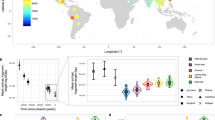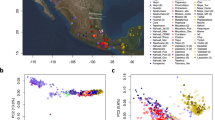Abstract
Microsatellite DMA sequences are rapidly becoming the dominant source of nuclear genetic markers for a wide range of applications, from genome mapping to forensic testing to population studies. If misinterpretation is to be avoided, it is vital that we understand fully the way in which microsatellite sequences evolve. We have therefore compared allele length distributions for 42 microsatellites in humans with their homologues in a range of related primates. We find a highly significant trend for the loci to be longer in humans, showing that microsatellites can evolve directionally and at different rates in closely related species.
This is a preview of subscription content, access via your institution
Access options
Subscribe to this journal
Receive 12 print issues and online access
$209.00 per year
only $17.42 per issue
Buy this article
- Purchase on Springer Link
- Instant access to full article PDF
Prices may be subject to local taxes which are calculated during checkout
Similar content being viewed by others
References
Tautz, D. & Schlotterer, C. Simple sequences. Curr. Opin. Genet. Devel. 4, 832–837 (1994).
Willems, P.J. Dynamic mutations hit double figures. Nature Genet. 8, 213–215 (1994).
Rubinsztein, D.C. et al. Mutational bias provides a model for the evolution of Huntington's disease and predicts a general increase in disease prevalence. Nature Genet. 7, 525–530 (1994).
Bowcock, A.M., Ruiz-Linares, A., Tonfohrde, J., Minch, E., Kidd, J.R. & Cavaili-Sforza, L.L. High resolution of human evolutionary trees with polymorphic microsatellites. Nature. 368, 455–457 (1994).
Deka, R. et al. Conservation of human chromosome 13 polymorphic microsatellite (CA)n repeats in chimpanzees. Genomics 22, 226–230 (1994).
Beckmann, J.S. & Weber, J.L. Survey of human and rat microsatellites. Genomics 12, 627–631 (1992).
Weber, J. & Wong, C. Mutation of short tandem repeats. Hum. molec. Genet. 8, 1123–1128 (1993).
Banchs, I., Bosch, A., Guimera, J., Lazaro, C., Puig, A. & Estivill, X. New alleles at microsatellite loci in CEPH families mainly arise from somatic mutations in the lymphoblastoid cell lines. Hum. Mut. 3, 365–372 (1994).
Jeffreys, A.J. et al. Complex gene conversion events in germline mutation at human minisatellites. Nature Genet. 6, 136–145 (1994).
Gray, I.C. & Jeffreys, A.J. Evolutionary transience of hypervariable minisatellites in man and the primates. Proc. R. Soc. Lond. B 243, 241–253 (1991).
Valdes, A.M., Slatkin, M. & Freimer, N.B. Allele frequencies at microsatellite lociithe stepwise mutation model revisited. Genetics 133, 737–749 (1993).
Dover, G.A. Evolution of genetic redundancy for advanced players. Curr. Opin. Genet. Devel. 3, 902–910 (1993).
Richards, R.I. & Sutherland, G.R. Simple repeat DNA is not replicated simply. Nature Genet. 6, 114–116 (1994).
Buard, J. & Vergnaud, G. Complex recombination events at the hypermutable minisatellite CEB1 (D2S90). EMBO J. 13, 3203–3210 (1994).
Napier, J.R. & Napier, P.M. A Handbook of Living Primates (Academic Press, London, 1967).
Duyao, M. et al. Trinucleotide repeat length instability and age of onset in Huntington's disease. Nature Genet. 4, 387–392 (1993).
Andrew, S.E. et al. The relationship between trinucleotide (CAG) repeat length and clinical features of Huntington's disease. Nature Genet. 4, 398–403 (1993).
Snell, G. et al. Relationship between trinucleotide repeat expansions and phenotypic variation in Huntington's disease. Nature Genet. 4, 393–397 (1993).
Jodice, C. et al. Effect of trinucleotide repeat length and parental sex on phenotypic variation in spinocerebellar ataxia I. Am. J. hum. Genet. 54, 959–965 (1994).
Brunner, H.G. et al. Influence of sex of the transmitting parent as well as of parental allele size on the CTG expansion in myotonic dystrophy. Am. J. hum. Genet. 53, 1016–1023 (1993).
Farrer, L.A., Cupples, L.A., Kiely, D.K., Conneally, P.M. & Myers, R.M. Inverse relationship between age of onset of Huntington disease and paternal age suggests involvement of genetic imprinting. Am. J. hum. Genet. 50, 528–535 (1992).
Reyniers, E. et al. The full mutation in the FMR-1 gene of male fragile X patients is absent in their sperm. Nature Genet. 4, 143–146 (1993).
Jansen, G. et al. Gonosomal mosaicism in myotonic dystrophy patients: Involvement of mitotic events in (CTG)n repeat variation and selection against extreme expansion in sperm. Am. J. hum. Genet. 54, 575–585 (1994).
Koide, R. et al. Unstable expansion of CAG repeat in hereditary dentatorubral-pallidoluysian atrophy (DRPLA). Nature Genet. 6, 9–12 (1994).
Rubinsztein, D.C. et al. B37 repeats are normal in most schizophrenic patients. Brit. J. Psych. 164, 851–852 (1994).
Slierendregt, B.L. et al. Major histocompatibility class II haplotypes in a breeding colony of chimpanzees (Pan troglodytes). Tissue Ant. 42, 55–61 (1993).
Li, S.H., Mclnnis, M., Margolis, R.L., Antonarakis, S. & Ross, C.A. Novel triplet repeat containing genes in human brain: Cloning, expression, and length polymorphism. Genomics 16, 572–579 (1993).
Gyapay, G. et al. The 1993–94 Généthon human genetic linkage map. Nature Genet. 7, 246–339 (1994).
Kwiatkowski, D.J. et al. Construction of a GT polymorphism map of human 9q. Genomics. 12, 220–240 (1992).
Jones, M.H., Yamakawa, K. & Nakamura, Y. Isolation and characterisation of 19 dinucleotide repeat polymorphisms on chromosome 3p. Hum. molec. Genet. 1, 131–133 (1992).
Paschen, W., Blackstone, C.D., Huganir, R.L. & Ross, C.A., GluR 6 Kainate receptor (GRIK2): Molecular cloning, expression, polymorphism, and chromosomal assignment. Genomics. 20, 435–440 (1994).
Oudet, C. et al. Characterisation of a highly polymorphic microsatellite at the DXS207 locus: confirmation of very close linkage to the retinoschisis gene. J. med. Genet. 30, 300–303 (1992).
Coleman, M.P. et al. Genetic and physical mapping around the properidin P gene. Genomics. 11, 991–996 (1991).
Porter, C.J., Nahmias, J., Wolfe, J. & Craig, I.W. Dinucleotide repeat polymorphism atthe human dopamine (3-hydroxylase (DBH) locus. Nucl. Acids Res. 20, 1429 (1992).
Stanier, P., Newton, R., Forbes, S.A., Ivens, A. & Moore, G.E. Polymorphic dinucleotide at the DXS3 locus. Nucl. Acids Res. 19, 4793 (1991).
Weber, J.L., Kwitek, A.E., May, P.E., Polymeropoulos, M.H. & Ledbetter, S. Dinucleotide repeat polymorphisms atthe DXS453, DXS454 and DXS458 loci. Nucl. Acids Res. 18, 4037 (1990).
Hugnot, J.P., Recan, D., Jeanpierre, M., Kaplan, J.C. & Tolun, A. A highly informative CACA repeat polymorphism upstream of the human dystrophin gene. Nucl. Acids Res. 19, 3159 (1991).
Clemens, P.R. et al. Carrier detection and prenatal diagnosis in Duchenne and Becker muscular dystrophyfamilies, using dinucleotide repeat polymorphisms. Am. J. hum. Genet. 49, 951–960 (1991).
Roux, A.-F., Yuan, C.C., Rommens, J.M. & Musarella, M.A. Dinucleotide repeat polymorphism near the RP3 locus in Xp21 (DXS1110). Hum. molec. Genet. 2, 821 (1993).
Jansen, G. et al. Physical and genetic characterisation of the distal segment of the myotonic dystrophy area on 19q. Genomics. 13, 509–517 (1992).
Moore, B.J., Kwan, S.P. & Bech-Hansen, N.T. A polymorphic dinucleotide repeat at the DXS7 locus. Nucl. Acids Res. 20, 929 (1991).
Fu, Y.-H. et al. Variation of the CGG repeat at the fragile X site results in genetic instability: resolution of the Sherman paradox. Cell 67, 1047–1058.
Hardwick, L.J., Brown, J. & Wright, A.F. An SIR polymorphism at the CYBB locus. Hum. Molec. Genet. 2, 1755 (1993).
Knight, S.J.L. et al. Trinucleotide repeat amplification and hypermethylation of a CpG island in FRAXE mental retardation. Cell 74, 127–134 (1993).
Orr, H. et al. Expansion of an unstable trinucleotide (CAG) repeat in spinocerebellar ataxia type 1. Nature Genet. 4, 221–226 (1993).
Tsai, Y.C. et al. Mosaicism in human epithelium: macroscopic monoclonal patches cover the urothelium. J. Urol. 153, 1697–1700 (1995).
Author information
Authors and Affiliations
Rights and permissions
About this article
Cite this article
Rubinsztein, D., Amos, W., Leggo, J. et al. Microsatellite evolution — evidence for directionality and variation in rate between species. Nat Genet 10, 337–343 (1995). https://doi.org/10.1038/ng0795-337
Received:
Accepted:
Issue Date:
DOI: https://doi.org/10.1038/ng0795-337
This article is cited by
-
Matamatas Chelus spp. (Testudines, Chelidae) have a remarkable evolutionary history of sex chromosomes with a long-term stable XY microchromosome system
Scientific Reports (2022)
-
Identification of putative markers linked to grain plumpness in rice (Oryza sativa L.) via association mapping
BMC Genetics (2017)
-
Genome-Wide Analysis of Simple Sequence Repeats in Marine Animals—a Comparative Approach
Marine Biotechnology (2014)
-
Analysis of average standardized SSR allele size supports domestication of soybean along the Yellow River
Genetic Resources and Crop Evolution (2013)
-
Rapid development of 36 polymorphic microsatellite markers for Tetranychus truncatus by transferring from Tetranychus urticae
Experimental and Applied Acarology (2013)



